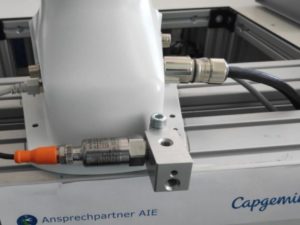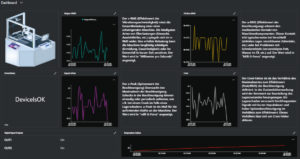Condition Monitoring of a Cobot by Capgemini
This post was originally published by Lukas Birn, Capgemini on produktion.de.
Benchmark by Capgemini: how fast can you integrate a simple solution like Condition Monitoring on a Cobot?
The Industrie 4.0 approach and use-cases like Predictive Maintenance are often not adopted in the day-to-day reality of industrial production environments yet. The existing implementations are oftentimes lighthouse projects with limited potential to scale.
To move the Industry 4.0 roadmaps forward from these isolated solutions, companies should strive for use-cases with low or medium complexity first. A good example of this is Condition Monitoring. We wanted to assess, how much time and effort such a solution could be implemented for a Cobot.
Integration benchmark by Capgemini
In the Capgemini Applied Innovation Exchange (AIE) center in Munich, a fully automated inspection cell is presented. A Cobot picks parts, moves them towards a camera lens, and then sorts them into configured boxes according to their identified type and inspection result. The control of this process, as well as the inspection through AI and the integration into Microsoft Azure, run as a containerized edge computing application on a local Lenovo SE350 edge server.
In a rapid hackathon, Capgemini wanted to benchmark the implementation time of a condition monitoring solution for the Cobot. The partners that assisted the integration test were the IIoT expert CloudRail and the sensor supplier IFM. In preparation for this hackathon, a suitable IO-Link vibration sensor was selected and the requirements for the cloud connectivity were coordinated. Altogether this was conducted in less than five minutes.
The implementation started on a Monday morning. While some team members were present on-site in Munich, others were participating remotely from Berlin, Stuttgart, and Mannheim. Within minutes, the sensor was mounted on the robot and wired to the gateway. The exciting question was, how fast the characteristic values of the sensors that indicate impacts, fatigue, friction, and temperature will be displayed in the cloud service.
Why programming skills are not required
About 15 minutes later, the CloudRail solution established connectivity to Azure IoT Hub, IoT Edge, and IoT Central, where a dashboard displayed the collected sensor values. Furthermore, the CloudRail solution automatically creates a semantic model through a so-called discovery service that automatically identifies the meaning of transmitted values.
Created through a so-called discovery service semantic sensor models that automatically identifies the meaning of the transmitted values. The CloudRail technology fully satisfied its promise of Plug&Play connectivity.
An important highlight of the benchmark was the complete remote configuration of the cloud connectivity that was conducted by a team member in another location. This proved that solely the hardware integration has to be done on-site with the Cobot.
The hackathon has confirmed that the Cobot could be retrofitted easily with a Condition Monitoring solution in less than 20 minutes. After a test phase, this service is being used as a monitoring solution for the Cobot. One of the benefits of this solution, IoT Central does not require any programming skills and offers several possibilities for the configuration of dashboards or rules that trigger alarms and functions using the collected sensor data.






